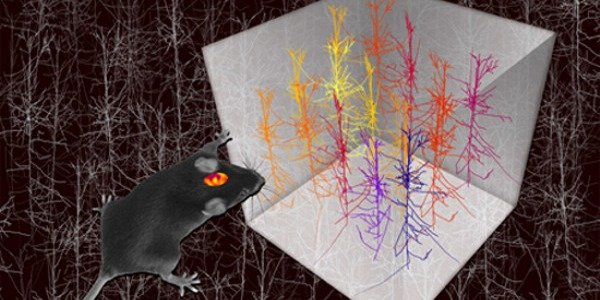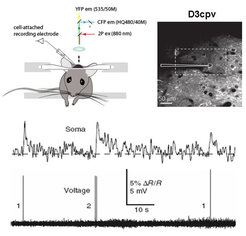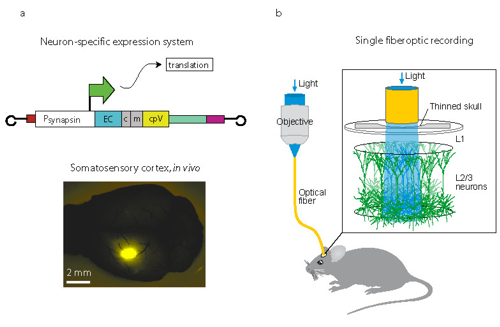
Population Imaging of neuronal activity with genetic calcium sensors
Imaging activity in the cortex

A D3cpv labeled neuron (upper right panel) shows fluorescence changes in the soma in response to single and double action potentials (lower panel).
To image a large number of neurons in layer 2/3 barrel field in vivo, we are using genetic Ca2+ sensor, D3cpv, as a reporter of neuronal activity in mice. With this sensor, we demonstrated that neuronal activity can be detected with single-cell, single-spike resolution (Wallace et al., 2008).
Imaging activity in the olfactory bulb
We generated transgenic mice that show robust expression of fluorescent calcium indicator proteins (FCIPs) in olfactory receptor neurons and granule cells. We then demonstrated that odor-evoked calcium responses can be visualized with high spatial and temporal resolution in these cell types by wide-field imaging in living mice (Hasan et al., 2004).

Figure (a) shows thinned olfactory bulb, (b) single-trial, odor-evoked (2-hexanone) activity map in the olfactory bulb and (c) Ca2+ activity trace (green and red) in two different regions during the time of odor presentation (grey box). Note that Ca2+ activity responses are phase-locked to respiration (black trace).
Imaging activity in the hippocampus
A genetic Ca2+ sensor, GCaMP2, was expressed in rat hippocampal organotypic slices and spatiotemporal population imaging of neuronal activity dynamics in CA3 neurons (left panel) could be detected in single trials (right panel). Simultaneous extracellular electrical recording (lower right panel) of the imaged brain slice is shown in the lower left panel.
Performed in collaboration with the Andreas Draguhn Lab, Institute of Physiology and Pathophysiology at the University of Heidelberg.

Fiberoptic recording of neuronal activity with a genetic Ca2+ sensor in freely-moving mice
To find correlations between cellular signals and animal behavior, a major challenge in experimental systems biology is to perform studies in freely-moving mammals and over an extended period. Among mammals, the mouse is a major genetic model for targeted manipulation of cellular properties. We can demonstrate non-invasive fiberoptic recording of population neuronal activity with a genetic Ca2+ sensor in freely moving mice. Dynamic changes in Ca2+ activity were observed from labeled neurons in the barrel cortex during resting, object-touching and moving, possibly reflecting different behaviorally-related brain states (Lütcke et al, 2010). The combination of optogenetic and fiberoptic methods appears well-suited for investigating the neuronal basis of animal behaviors, aging and neurological diseases.
Functional expression of YC3.60 in vivo

(a) YC3.60 expression in neurons under control of the human synapsin promoter (PhSYN). A fixed mouse showing YC3.60 expression (YFP fluorescence).
(b) Schematic diagram of experimental design. Population Ca2+ activity of neurons in somatosensory cortex were recorded with single core optical fiber.

(c) Fiberoptic Ca2+ recordings from a freely moving mouse. Ca2+ responses (shown in black) and animal behavior (color coded) for an imaging session of 25 seconds are overlayed and specific animal behaviors are indicated on the x-axis with arrow heads.
![[""]
A D3cpv labeled neuron (upper right panel) shows fluorescence changes in the soma in response to single and double action potentials (lower panel).](/62803/original-1311676586.jpg?t=eyJ3aWR0aCI6MzQxLCJmaWxlX2V4dGVuc2lvbiI6ImpwZyIsIm9ial9pZCI6NjI4MDN9--19855d6ce8bfd533f8a062925f3e5eab8250b6a8)